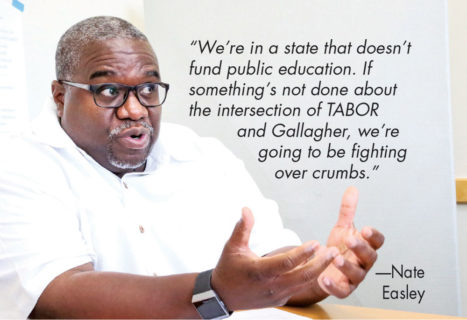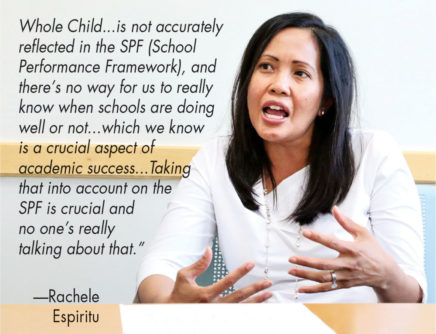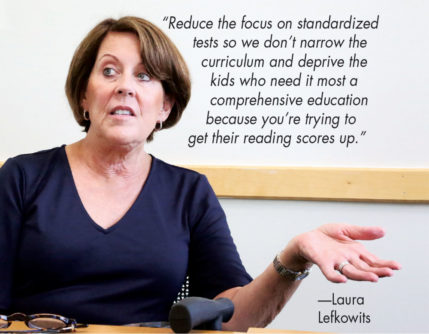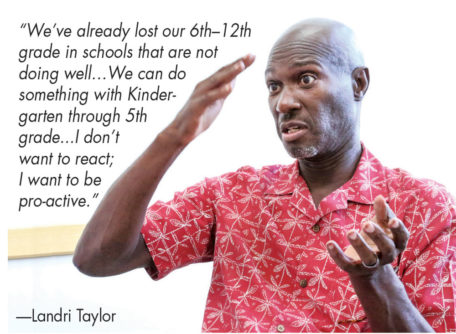
Left: Former Superintendent Tom Boasberg, pictured at DSST: Stapleton (now Montview), came from a business background. He instituted SchoolChoice and the portfolio concept that includes charter schools, like DSST, among other “reforms.” Right: During Boasberg’s tenure, Ashley Elementary underwent a controversial staffing and programming change in an effort to raise academic achievement. Middle: The new superintendent, Susana Cordova, started as a DPS student and rose through the ranks from teacher to administrator. Time will tell how DPS policy may change with new board members and a new superintendent.
With the Denver Public Schools (DPS) Board election coming this fall, the Front Porch brought together four former Board members to share wisdom born of experience. They emphasize the board’s role as the public’s voice in policy-making for DPS and chime in on issues they see as important in the November election, when three seats are up. Northeast Denver voters will be choosing one at-large member. Our October issue will introduce the candidates.

Nate Easley, School Board Member 2009-13.
The seven-member school board for the state’s largest school district—District 1, Denver Public Schools—will soon replace three of its members. Calls to “flip the board” have garnered headlines and a flurry of social media posts. Four former school board members sat down with Front Porch in August to chime in on some of the issues and questions they believe merit voters’ and candidates’ attention. Dr. Laura Lefkowits (1995-99), Nate Easley (2009-13), Landri Taylor (2013-16), and Dr. Rachele Espiritu (2016-17) shared the wisdom born of good and bad decisions made during their respective tenures. The frank and far-reaching conversation emphasized several themes, including the importance of the board’s role, equity and school choice, and the budget.
The School Board’s Role

Dr. Rachele Espiritu, School Board Member 2016-17.
“When I was on the board, the board was the initiator of policy and the district had to implement it. So, I would want to ask candidates: ‘What is your view of the role of the board?’” says Lefkowits. She would like to see the board return to its previous leadership role, and asks candidates: “Do you view yourself as the leader of the district, and the superintendent works for you and carries out policy that you as a 7-member board develop, or do you see yourself…as following the superintendent’s lead?”
Easley reflects on state statutes that define a board member’s role, which he states is “to represent the public to the district as an elected official, and not the reverse…and to govern, and not manage.” Easley continues, “You have to have a special relationship with all of your colleagues, because that’s how you make policy. If you don’t, then you give the superintendent and teachers union more power.”
Equity and SchoolChoice
Though SchoolChoice offers families the opportunity to select a curriculum and a school that best fits their child, it does not serve all families equally; and it does not ameliorate the district’s pervasive inequities. The 206 DPS schools vary widely in resources, educational achievement, and other measures. Low-income students and students of color especially lag behind their middle-class and white peers on standardized test scores, for example. In this respect, SchoolChoice remains elusive and illusory for families without transportation to a highly-rated school.

Dr. Laura Lefkowits, School Board Member 1995-99.
Reflecting on the inequities that have surfaced in SchoolChoice, Lefkowits says “We should have controlled that choice.” She praises current voluntary efforts by schools to guarantee a percentage of seats to low-income and/or underrepresented students, as a way of fostering greater equity. The school board could craft policy along these lines to promote equity across the district. Lefkowits says she plans to ask board candidates “How do you guarantee equitable access to education?” given the portfolio model within DPS, which offers a diverse array of schools with varying degrees of school autonomy.
Easley recognizes the privilege that comes with his address, education and income, which ensure his children a great public-school education. “DPS can do nothing to take my choices away from me,” says Easley, who observes that middle class and wealthy families always have a choice, which may include moving their children into private school. His “gold standard” for the district, however, is whether or not he would send his own child to a particular school.

Landri Taylor, School Board Member 2013-16.
Beyond equity, (lack of) true integration is a key concern. Easley contends that schools are about as segregated now as they were prior to the Brown decision that in 1954 mandated desegregation. “How are we going to desegregate our schools?” asks Easley. He counsels a shift in mentality from a deficit-mindset to an asset-mindset, and employs the example of bilingualism. For him, students who speak a foreign language in the home represent an asset to a school community and their presence should be reframed as such, rather than representing English language learners as a deficit within a school population. Lefkowits recommends prioritizing meaningful, ongoing professional development to promote greater cultural sensitivity as a way to promote equity.
“What is current policy around the CSCs (Collaborative School Committees) in the schools?…That’s a good place to think about where the board has a role,” says Espiritu.
Budget
Constrained as DPS is due to the 1982 Gallagher Amendment and 1992’s Taxpayer Bill of Rights (TABOR), the former board members acknowledge the district’s financial challenges as it seeks to meet the wide-ranging needs of 91,794 students. Taylor contends that even with these constraints, the district can do more by putting the right people in place.
Lefkowits acknowledges that giving schools more discretion in their budgets offers them flexibility but says the district risks losing continuity in areas that should remain priorities. Espiritu echoes that concern. With the reduction in central office staffing in the wake of the 2019 teachers’ strike, individual schools may be implementing programs, but lack of district-level funding leads to an absence of cohesion. As a result, when students move within the district to new schools, there may not be consistency, diluting the value of those programs.
Easley emphasizes investment, both in financial terms and in terms of how we assess our school population’s assets. “Right now we just talk about deficits,” he says, “but if we seek further buy-in from parents across the district—from low-income to wealthy— the emphasis needs to shift to one that recognizes the district’s assets, including the inherent value of sending one’s child to a school with a diverse population.”
Moving Forward
As these former board members shared their lessons learned, the crucial importance of institutional memory becomes apparent. The incoming board will provide direction to DPS as they develop a new strategic plan with the impending conclusion of Denver 2020. “We ask the public about flipping the board, and I don’t know if they’re clear on it…either they’re mad about something, they don’t like something or they think it’s just a good idea for change, not knowing what they’re looking for,” says Taylor.



Wow. Where are the interviews with Jeannie Kaplan and Arturo Jimenez?